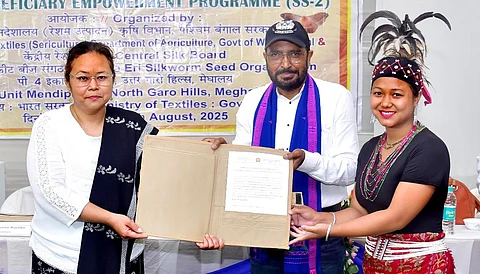
- Home
- Live Blog
- Breaking News
- Top Headlines
- Cities
- NE News
- Sentinel Media
- Sports
- Education
- Jobs

A CORRESPONDENT
BOKO: The Central Silk Board (CSB) along with West Bengal’s Directorate of textiles (Sericulture) Department of Agriculture, Mendipathar P-4 unit, jointly organized a four-day long residential training of Muga and Eri seed rearers under beneficiary empowerment programme under the Silk Samagra-2 (SS- 2) scheme at Mendipathar along the Assam-Meghalaya border in North-Garo Hills district of Meghalaya.
The training programme was inaugurated by Yosima W Momin, ADC, NGH district, Dr Arup Krishna Thakur, Joint Director, (NZ) DOS, West Bengal, Dr N K Bhatia, Director, MESSO, CSB Guwahati, and Mahasankar Mazumdar, Scientist-C, MESSO, Mendipathar. The programme was kicked off with Garo traditional dance ‘Wangala’ performed by the Medhipara College students who also finished their 19 days of training on Muga and Eri production recently. The Silk Samagra-2 or SS-2, a government scheme in India aimed at the integrated development of the silk industry. This scheme, with a total outlay of Rs 4,679.85 crore for the period 2021-22 to 2025-26, focuses on improving silk production, quality, and productivity, while also generating employment opportunities, particularly in rural areas.
During the programme, a meeting was held at the Mendipathar CSB Campus where guests welcomed the trainees and highlighted the benefits and properties of Muga and Eri silk in detail. As a part of the programme, the invited guests also distributed certificates to the nine students from Mendipathar College who completed their internship programme on Muga Culture at Mendipathar CSB Centre. Dr NK Bhatia, Director, MESSO, CSB Guwahati, said that total 35 farmers from Kalimpong, Darjeeling, Alipurduar, Jalpaiguri, and Coach Bihar under West Bengal District has come to Mendipathar in Meghalaya for training on Muga and Eri production increasing with various techniques and various methods to develop themselves in this Muga and Eri sectors.
Bhatia emphasized that more than four thousand tribal women from Alipurduar worked on Eri productions. “They produced eggs from eri silk moths and then it grows to the larva than pupa and it becomes cocoons and later yarn comes from the cocoons. They sell yarn and various clothes and dresses in the markets and thus they have been working at home and earning profits with independence,” added Dr Bhatia.
Also Read: Guwahati: Latasil police arrest woman on charge of stealing Muga sets
Also Watch: